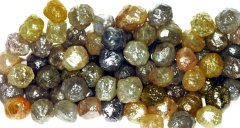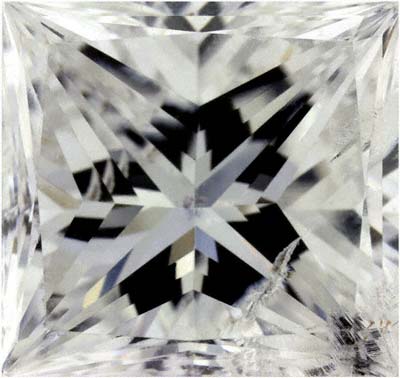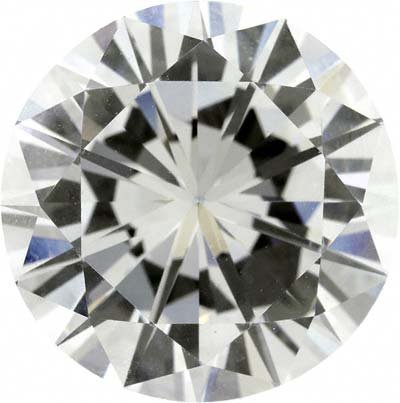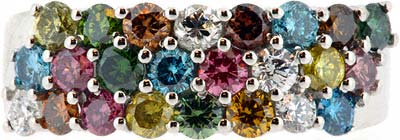| The Very Highest Quality Diamond Jewellery... |
| Diamond |
|
|

|
|
|

|
|
|

|
|
|

|
|
|
A: Diamond is Carbon
It may seem surprising that diamond is simply carbon, just like charcoal or graphite. In fact carbon has at least two other rare, and only recently discovered forms, or allotropes, known as fullerenes.
The difference is caused by the different types of bonding between adjacent atoms to form different types of crystalline structure.
In diamond, each carbon atom is bonded to four other carbon atoms in a tetrahedral structure, like a pyramid. Each link or bond is the same length, and the tetrahedral formation is therefore completely regular. It is the strength and regularity of this bonding which makes diamond very hard, non-volatile and resistant to chemical attack.
Theoretically a perfect diamond crystal could be composed of one giant molecule of carbon.
Carbon is a non-metallic element with the atomic number of 6, and an atomic Weight of 12. In combination with oxygen and hydrogen it is contained by all living objects. In the form of graphite it appears black or dark gray, opaque, and is very soft, whereas in the form of diamond is it clear, colourless, and extremely hard. In fact diamond is the hardest known naturally occurring substance.
Carbon has a density of about 2.3 and diamond about 3.5.
What Makes Diamond An Ideal Gemstone?
Diamond possesses many qualities which make it an ideal gemstone.
It is extremely hard, and also very tough and hard-wearing, and this also helps it to take a very high polish. Some hard articles are brittle which detracts from their durability. There are some things which are harder than diamond.
In its pure form it is colourless, has a high refractive index, so has a very high lustre.
It possesses high dispersion, meaning that different light wavelengths are diffracted differently, giving a strong scintillating play of prismatic colours.
Diamond Discoveries
Diamonds seem to have been known for about 3,000 years, being mentioned in Exodus chapter 28, however in early times, other hard minerals were often confused with diamond.
It is thought that the earliest diamonds were found in about the 12th century B.C., in India , which remained the most important, if not the sole, source until 1725, when diamonds were discovered in Brazil.
The Indian and Brazilian deposits had been almost exhausted when in 1866, the Eureka diamond was discovered in South Africa, followed by the Star of South Africa in 1869. Shortly afterwards, the great South African diamond rush had started, and South Africa remains one of the world's most important sources of diamonds today.
Diamonds have since been discovered in many other regions of the world, including Russia and Australia.
Until the South Africa finds, diamonds were so rare and valuable, that they were only owned by the very wealthy. They were not available in high street shops!
Why Are Diamonds So Popular?
Through the publicity and promotion given to diamonds largely by the De Beers Company, and through the Diamond Promotion Service, diamonds have become the most desired gemstone.
Thanks to large scale mining, and the development of efficient cutting methods and equipment, diamonds have now become a consumer luxury affordable to the masses.
Mass production jewellery manufacturing techniques have also helped to bring diamond rings and other diamond jewellery into very affordable, even commodity, price ranges.
Man Made
Another fact about diamond which surprises most people, is that more diamond is now manufactured than mined.
Synthetically produced diamonds have been made since at least 1954, although the bulk of the synthetic production is used for industrial purposes as diamond grit.
Gem quality synthetic diamonds have also been produced, although it is still more expensive to manufacture them than to mine them.
Colour:
Pure diamond, if such a thing exists, is colourless.
Most diamonds are slightly coloured, even if the colouring is almost imperceptible. The commonest colour is yellow which is caused by tiny amounts of nitrogen being present in the crystal structure, others are gray, light brown or greenish. Diamond can be almost any colour, although strongly coloured attractive specimens are very rare, and as such are not actively promoted by De Beers, probably in case consumers realise that blue, red, green and other colours are attractive, and start buying sapphires, rubies, emeralds and other gemstones instead of diamonds!
As with many gemstones, colours can be artificially produced or modified. Some fancy coloured diamonds are produced by irradiation and subsequent heat treatment. Natural fancy coloured diamonds command very high prices, especially the more more popular colours. Fancy coloured diamonds where the colour has been artificially produced are no less beautiful, but sell for more normal prices.
We occasionally have fancy coloured diamonds available in blue, green, yellow, orange, pink, purple, brown, and even black.
Clarity
It is well known that most diamonds contain slight imperfections or flaws, indeed I firmly believe that there is no such thing as a perfect diamond. The higher the clarity grade of a diamond, the higher its desirability, and therefore its price.
Cut, Proportion, and Shape
Most jewellers will tell you that "cut" is an important factor in the price of a diamond. While this is true, most do not know clearly what they mean by the word "cut". It can have several different meanings.
Firstly, it can describe the shape and facetting pattern of the diamond, as in the modern round brilliant cut, the single or eight cut, pear shape, emerald cut, square, baguette, oval, heart, triangle, princess, marquise or fancy.
Secondly, it can mean the accuracy of the facetting, and the proportions of the stone, and lastly it can apply to the polish or surface finish of the stone.
Simulants
There have always been things which looked like diamonds, but were not diamond. I have already stated that in early times other stones were confused with diamond.
Any stone which looks like a diamond could be called a diamond simulant. Natural or synthetic white sapphire, glass, colourless quartz (rock crystal), rutile both natural and synthetic, yttrium aluminium garnet (YAG), strontium titanite, cubic zirconia, and now moissanite, all simulate diamond to a greater or lesser degree.
Do not confuse simulant with synthetic. A synthetic diamond is real diamond, but not natural diamond. A simulant can be natural or synthetic, but is not the same as the material it imitates.
The most abundant synthetic is cubic zirconia (CZ), which is a remarkably good simulant. If it is set in a high quality realistic mount, it is undetectable to the naked eye without instruments.
Moissanite is the latest synthetic simulant, and is very realistic looking, and quite difficult to differentiate from diamond.
| Gemstone Name | Diamond |
| Chemical Composition | Cn |
| Chemical Name | Carbon |
| Hardness | 10 |
| Refractive Index | 2.42 |
| Bi-refringence | 0 |
| Specific Gravity | 3.52 |
| Crystalline System | Cubic |
| Dispersion | 0.044 |
| Thermal Expansion | 1 |
| Atomic Number (Carbon) | 6 |
| Atomic Weight (Carbon) | 12.0107 |
| CAS Registry ID (Carbon) | 7440-44-0 |
| Atomic Group Number (Carbon) | 14 |
| Atomic Block (Carbon) | p-block |
If you would like to know more about the factors which affect the quality of diamonds, and therefore the price, we have prepared a whole section for you, devoted solely to diamond information - Diamonds - The 4C's and Beyond
If you would like to know how quality affects price, please take a look at our price example pages:-
Price v. Quality of a 1 Carat Diamond or
Price v. Quality of a Half Carat Diamond
| ...at the Lowest Possible Price |
|
32 - 36 Harrowside, Blackpool, Lancashire, FY4 1RJ, England. Telephone (44) - (0) 1253 - 343081 ; Fax 408058; E-mail: The URL for our main page is: https://24carat.co.uk | Chard(1964) Ltd |